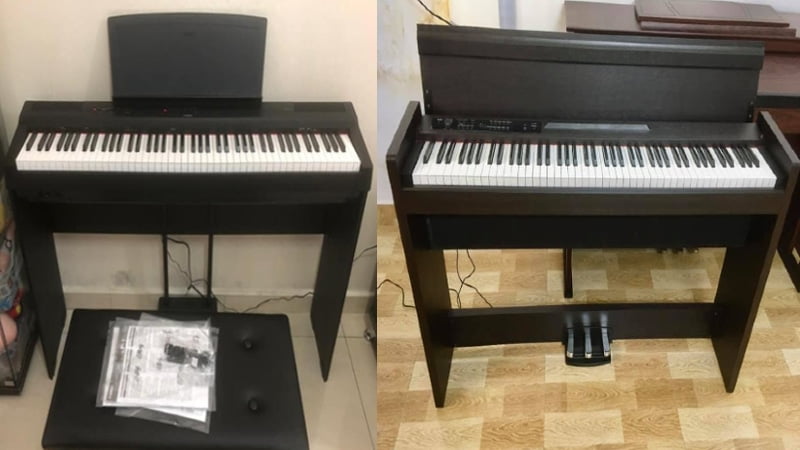Learn why the Yamaha P-125 is the better piano in this Yamaha P125 vs Korg LP 380 review.
When it comes to digital pianos, Korg and Yamaha are some of the best brands out there. And two pianos from these brands I’ve been wanting to compare for a long time are the Yamaha P125 and the Korg LP-380.
Both of these options would be great for any pianist, which is why there are many people eager to learn which model is better. And after doing a bunch of tests and researching the features of both pianos, I found that the Yamaha P-125 is the clear winner.
Despite being the more affordable option, the Yamaha P-125 comes with richer tones, and more features, and is the more flexible piano over all. Even if the Korg LP-380 was able to compete with the P-125 in almost every comparison point, it ended up falling short in this review.
If you’re looking to learn which piano is better for your needs and why you’ve come to the right place.
I dive into the features of both pianos in this article and explain the different features and benefits of each. And by the end of this comparison, you’ll know exactly which model is best for you!
Yamaha P125 vs Korg LP 380: Comparison Chart
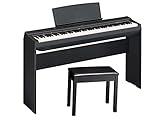



Last update on 2025-07-01 / Affiliate links / Images from Amazon Product Advertising API
Yamaha P125 vs Korg LP 380: A Head-to-Head Comparison
Comparing two digital pianos isn’t an easy task, even if the pianos are as different as the Yamaha P-125 and the Korg LP-380. But to find an objective winner between the two, I decided to compare the features of both pianos against each other.
By the end of my comparison, the score was 3-1 in favor of the Yamaha P-125. Since it’s more portable, versatile, and has richer tones, I felt like the Yamaha was the easy winner between the two. But keep reading if you want to learn how and why the Yamaha P-125 beat the Korg LP-380.
Feel
The winner: Tie
I usually check out the feel of a digital piano when I first test it. That way, I can check how well it emulates the feel of an acoustic piano and whether it can provide an authentic playing experience. And between the Yamaha P-125 and the Korg LP-380, I couldn’t choose a winner when comparing the feel.
These pianos use different hammer action systems, but I found that there was barely a difference between the two. So, if you’re looking for a piano that can easily replicate the feel of a real acoustic piano, either one of these options does a decent job.
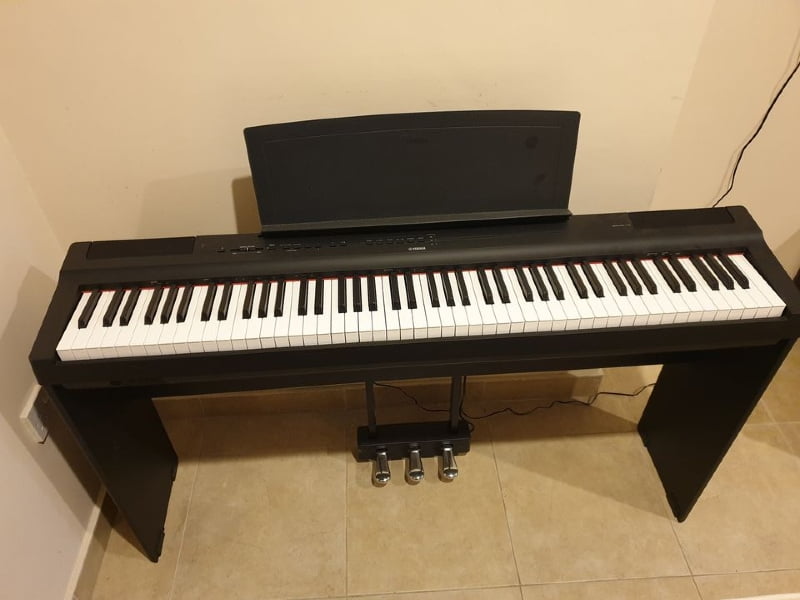
+Hammer Action
The Yamaha P-125 uses the Graded Hammer Standard or GHS hammer action system. This is a signature feature of many Yamaha pianos as it replicates the subtle weight differences between piano keys. This means that the lower keys are significantly heavier than, the lighter keys, which is something you’d expect when playing an acoustic piano.
There aren’t many hammer action systems in this price range compared to Yamaha’s GHS. However, I was pretty surprised to find that the Korg LP-380 also replicates the feel and weight differences on an acoustic piano while using a completely different hammer action system.
The Korg uses the RH3 real hammer action system. This can be seen as the Korg equivalent to GHS, so it provides a similar weight. In fact, when I tested out both pianos, I could barely tell the difference when judging the weight of the keys.
That said, the Yamaha has a slight advantage as you have hard, medium, soft, and fixed touch sensitivity. This allows for more dynamics when playing compared to the Korg’s light, heavy, and medium touch sensitivity.
+Key Texture
In terms of key texture, both of these pianos were a slight letdown. Now, considering the price range of both pianos, I wasn’t expecting real wooden keys. However, I have to say that both pianos could have performed better when it came to key texture.
Both pianos use glossy plastic keys. There isn’t anything wrong with this, as this is an affordable route for manufacturers. However, if you’re used to playing an acoustic piano, you’ll definitely notice the glossy texture of the keys.
An easy fix would have been adding a matte coating to the keys so they don’t feel as plastic-like. This probably would have raised the price of the pianos, which is why Korg and Yamaha decided against adding a key coating.
It doesn’t make that much of a difference, but it still would have been nice to see coated keys on at least one of these pianos.
Tone
The winner: Yamaha P-125
This is arguably the most important feature of any digital piano. Tone refers to the sound that the piano produces, and the Yamaha was the clear winner between these two options.
To start, it has a much better tone generator that replicates the sound of Yamaha grand pianos. Granted, the Korg has a slightly more flexible sound library, but since the sound quality of the Korg’s voices isn’t as good as the Yamaha, I decided to give the point to the Yamaha P-125.
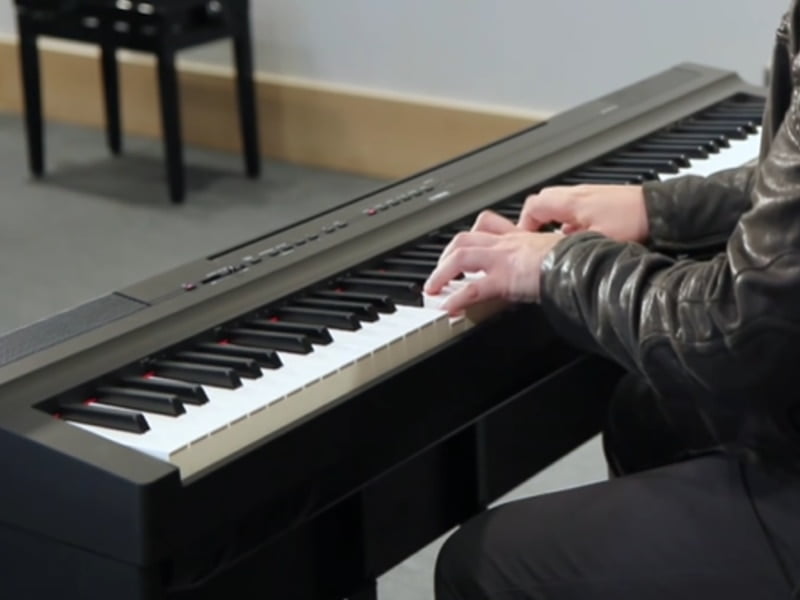
+Tone Generator
The Yamaha P-125 uses the Pure CF tone engine. The piano is loaded with various high-quality samples that you trigger whenever you press a key. The difference between this tone engine and others on the market is that Yamaha recorded the samples from the Yamaha CF Grand Pianos, which are some of the most popular grand pianos on the market.
On top of that, Yamaha records high-quality stereo samples so that you can expect a bit more realism in the piano tones.
The one complaint I had with the Korg is that it uses a generic Stereo Piano System. While the piano tones are high-quality, they pale compared to the Yamaha’s brightness and fullness.
+Sound Library
The Korg has a wider sound library than the Yamaha, but it isn’t by a lot. You’ll be able to choose between 24 top-quality voices on the Yamaha P-125. This includes piano, electric piano, strings, bass, and organ sounds.
The Korg has 30 tones, so you have a couple more choices. But since the sound quality on the Korg isn’t as good as the Yamaha, it wasn’t enough to give it the point in this comparison.
That said, I do have to mention the electric piano tones on the Korg. These voices are very high-quality and some of the best in their price range. Granted, the piano tones leave a bit to be desired, but the electric piano tones exceed the expectations of this price range.
Piano Features
The winner: Yamaha P-125
The last comparison point I had between these two pianos is the extra features. And again, the Yamaha P-125 comes out on top as it has more playing modes and a great effects set that make this a very versatile digital piano.
+Playing Modes
The P-125 comes with split, duo, and layering modes. The Korg, on the other hand, only has duo and layering modes. All of these modes make the pianos more versatile, but since the P-125 comes with more playing modes, I had to give it the point.
With split mode, you can divide the piano into two smaller keyboards with different voices. This gives you a lot of versatility as you can fill in more sonic space. And with layering mode, you can combine two voices together to produce a unique tone.
Lastly, you have duo mode. This mode is designed for piano lessons and duets as it divides the piano into two smaller keyboards with the same pitch and timbre. That way, you and another person can play together as if you had one piano each.
+Effects
In terms of effects, I prefer the options on the Yamaha. With reverb, IAC, damper resonance, and a sound boost, you have just about everything you need for performances and for practice.
That said, the Korg comes with reverb, chorus, and brilliance. Now, I didn’t find these effects more useful than the ones on the Yamaha. However, there are definitely many pianists out there who would find this set to be more versatile than what you’ll find on the Yamaha.
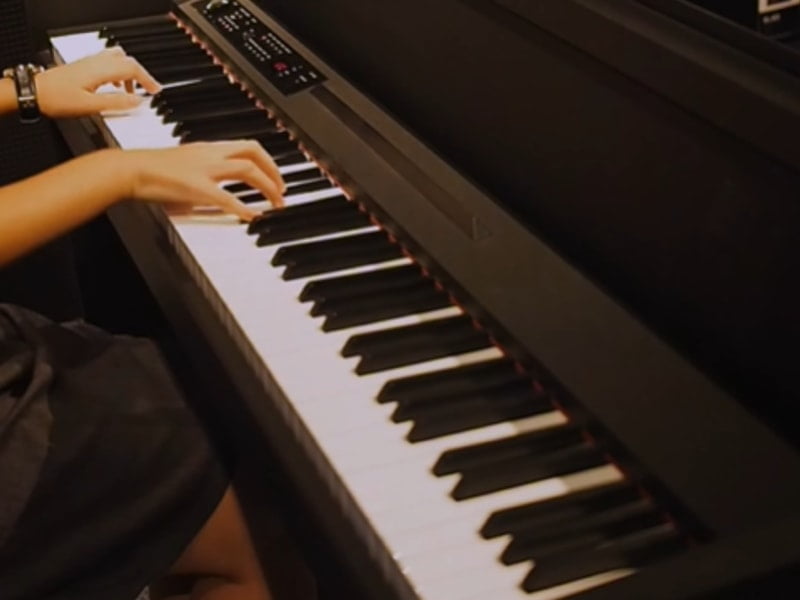
Yamaha P125 vs Korg LP 380: The Similarities
These pianos don’t share that many similarities. These are very different instruments designed for different pianists. While they both have weighted keys and come from reputable brands, these two pianos couldn’t be more different.
The Yamaha P-125 is more of a workhorse. It’s designed for you to bring it around to jams, practice, lessons, and performances. And since this is a more versatile and flexible option, I chose it as the winner.
However, the Korg-LP-380 could be the better option for some pianists. It’s not portable and is designed to stay in one place for a long time. However, you do get some pretty rich tones and a realistic piano feel, which is what some people look for when buying digital pianos.
Quick Rundown of the Yamaha P125
- Solid Steel Housing, Made in Italy
- 9 Bar Espresso Extractions
- Stainless Steel 58mm Commercial Portafilter
- Commercial Three Way Solenoid Valve
- Commercial Steam Wand
Last update on 2025-07-01 / Affiliate links / Images from Amazon Product Advertising API
Quick Rundown of the Korg LP 380
Last update on 2025-07-01 / Affiliate links / Images from Amazon Product Advertising API
Product Videos
Related Articles to Yamaha P125
- Yamaha P150 vs P125: The Battle of the P-Series Models
- Yamaha P125 vs CLP 625: Can a Beginner’s Digital Piano Match the Clavinova?
- Yamaha P125 vs Roland FP 60: Which is the Better Investment?
- Yamaha P-121 vs P-125: Finding the Best Portable Yamaha Piano
- Yamaha P125 vs P85: Can the Outdated Digital Piano Beat the Newer One?
- Yamaha P125 vs DGX 670: Which Piano Comes Out on Top?
- Yamaha P125 vs Korg SP 280: Which is the Better Beginner’s Digital Piano?
- Yamaha P-255 vs P-125: Finding the Better Option for Beginners
- Yamaha P125 vs YDP S34 Comparison: Does the Portable P125 Hold Up Against a Console Digital Piano?
- Yamaha P125 Vs YDP 164: Should You Get A Console Or Digital Piano?
- Yamaha YDP 103 Vs P125: Should You Get a Portable or Console Digital Piano?
- Yamaha P125 Vs Kawai ES110 Comparison: Which Is The Best Portable Digital Piano
- Yamaha P125 vs Casio PX S1000: Which Digital Piano Is Worth Your Money?
- Casio PX-870 Vs Yamaha P-125: Should You Get A Portable Or Console Digital Piano?
- Alesis Recital Vs Yamaha P125: Which Is The Right Pick For You?
- Yamaha P45 VS P115: Which P-Series Newbie Gives You More Value for Money?
- Alesis Recital Pro vs Yamaha P125 Comparison: Which Is The Best Portable Digital Piano?
- Alesis Prestige Artist vs Yamaha P125 Comparison: Why the Yamaha P125 Is the Better Investment
- Yamaha P125 vs Casio PX-770 Review: Why the Yamaha P125 Beats Out the Casio Console Digital Piano
- Yamaha P125 vs DGX 660 Comparison: Can the P125 Hold Its Own Against the DGX 660?
- Yamaha P125 vs Roland FP-30X Review: Why the Roland FP-30X Comes Out On Top
- Yamaha P125 vs P515 Review: Why the Yamaha P515 Is the Better Investment
- Yamaha P115 vs P125 Review: Can the P125 Beat Out Its Predecessor?
- Yamaha P125 vs Roland FP30: A Close Battle Between Two Great Digital Pianos
- Yamaha P45 vs P125: Why the Yamaha P125 Is the Better Pick for Pianists
- Yamaha P71 vs P125: Why the Yamaha P125 Is the Better Investment
References:
- Yamaha P125: https://usa.yamaha.com/products/musical_instruments/pianos/p_series/p-125/specs.html#product-tabs
- Korg LP-380: https://www.sweetwater.com/store/detail/LP380USB–korg-lp-380-u-digital-home-piano-black
Lulacruza is an electronic folk duo operating at the junction of the hypermodern and the ancient. Our music weaves together hypnotic female singing, South American folk instruments and electronic processing, while channeling pulsating waves from the source of creation.
Lalucruza is also a community where you can connect with other music lovers to collaborate, exchange ideas and share knowledge. A platform for who wants to learns the basics of playing piano, guitar, drum masters’ technique, etc.. is the premise of our website.
